Join 10,000+ marketers getting monthly digital tips and trends.

Design and UX
Experience research guide - what is ux and cx research.
Originally published in
Get our newsletter
They sound similar, they’re closely related, and they’re both crucial to your business, but CX and UX are separate things.
User experience (UX) is a subset of overall customer experience (CX) – and both are key investments for businesses aiming to deliver value, grow market share, and retain customers.
In fact, 64% of CX leaders expect a budget increase for CX initiatives in 2024.
Improving customer experience starts – and never ends – with having the right data to inform your strategy and it's a moving target.
Nearly all of CX leaders (99%) report they have changed their digital CX strategy over the past 18 months.
Quality data and thorough research are the backbone of CX strategy. So, what is UX and CX research then, and how does it factor into your brand’s future?
Let’s explore the relationship between these important experience types, the goals of UX and CX research , and important metrics to help you get it right to drive business growth and increase customer satisfaction.
You'll learn:
- Is CX similar to UX?
- How does CX and UX work together?
- What is UX and CX research?
- What is the goal of UX research?
- What is the goal of CX research?
- What is part of UX research?
- What is part of CX research?
- What are the metrics for CX and UX?
Is CX Similar to UX?
Before we jump into the differences between user experience and customer experience research methods , let’s look at the definitions for UX vs CX , by Nielsen Norman Group (NNGG):
- “User experience (UX) encompasses all aspects of a person's interaction with a company, its services, and its products.”
- “Customer experience (CX) describes the totality of the interactions that a user has with an organization over time.”

Consider this hypothetical example to better understand UX and CX differences:
You launch Amazon’s mobile app and decide to buy a t-shirt. That process – navigating the selection styles and sizes, adding it to your cart, and clicking “Buy Now” – are all parts of the user experience.
But, your interactions with Amazon don’t stop there. What if you need to return the shirt? Can you get someone on the phone if you have a question? How do you feel about the emails you receive from Amazon? All these components and more make up the customer experience.
“UX is more focused on one distinct platform or site, or a singular touchpoint,” says Nate Ginesi, Director of Experience Architecture at Whereoware. “Whereas CX has to do with all the touchpoints a user may encounter.”
So, UX and CX are interdependent, working in concert to create more valuable customer interactions.
How Does CX and UX Work Together?
When considering the CX and UX design of your website, it’s important to remember that these functions work hand in hand.
“At Whereoware, our UX design is always informed by multiple factors,” says Ginesi. “Think: visuals, usability, and accessibility. Ask your team, can everyone understand and use our platform? Do things act as they’re expected to? It’s like, when you see a handle on a door, you know to pull it and expect it to open. The user’s journey must be equally as clear.”
Even as best practices evolve and companies fine-tune their user experiences, there’s always a new challenge around the bend.
“If you incorporate, say, a chatbot on your site to help with customer service, you have to make sure it’s useful,” says Whereoware’s Creative Director, Tim Frost. “Customers will rightly expect a seamless experience every time.”
UX may be a subset of CX, but it’s a crucial one - when the UX is bad, the CX always takes the hit.
What is UX and CX Research?
“We’ve seen incredible things happen when you listen to the customer,” Tim Frost shares.
So, now you’re ready to uncover the best user experience and customer experience research methods.
The goal of UX research is to understand the best ways to improve a product's design or functionality, where as CX research aims to improve all aspects of a customer's total experience and create a loop of continuous insights, optimization, and value.
Where do you start? UX research terms can be broken down into two categories qualitative and quantitative:
- Qualitative research tries to understand how customers feel and what they think about their experiences. It uses methods like interviews, group discussions, diary entries, and surveys with open-ended questions.
- Quantitative research collects data about how people act, using numbers and statistics. It is based in data and experimentation to measure performance and results of optimization efforts. It includes methods like: testing how easy a website is to use, analyzing where customers drop off, and experimenting with two versions of a webpage to see which one works better. Qualitative research is more opinion-based and supported by quantitative data to back it up.
Ultimately, CX research tells businesses how to better serve their customers.
Devoted customers will pay 50% to 200% more to stay with your brand — with CX being the key to that loyalty.
While traditional approaches to research focus on interviews and surveys, technology is fueling new ways, enabling businesses to view, measure, and analyze digital experiences in real time.

What is the Goal of UX Research?
The primary goal of UX research is to improve both the design and functionality of a product, thereby elevating the overall user experience.
By employing various types of UX research , we continuously ensure that the user encounters no points of frustration," Tim Frost explains, “As usual, data and experimentation lead the way in how to remove frustration. We’re trying to understand users' needs, preferences, and challenges to inform how to make a more intuitive and satisfying product experience.
What is the Goal of CX Research?
The goal of CX research is to examine the entire customer journey to improve it, including interactions with customer service and other in-person and online channels.
CX research reveals to businesses where customers get confused, stuck, or satisfied. It shows how they interact on different channels, common questions they have, or other pain points.
With these insights in hand, companies can enhance the total customer experience, fostering lasting brand loyalty.
A significant 58% of American consumers say they will switch companies because of a negative customer service experience. That makes CX research invaluable – let’s dig deeper in how to approach it.
What is Part of UX Research?
UX research aims to understand users' needs, behaviors, and motivations to inform the design process.

While there are numerous angles, NNgroup lays out several key UX research methods :
- A/B testing: A classic form of experimentation in which two different versions of something are compared to see which one is most effective.
- Card sorting: A research method that helps you discover how people understand and categorize information.
- Clickstream analytics: Analyzing the sequence of pages a user visits, unveiling typical navigational routes, or potential journey blocks.
- Focus groups: A qualitative research method that focuses on a small group of people to explore their opinions, perceptions, and attitudes on a specific topic.
- Prototype testing: The process of testing an early version of a product or feature with real users.
- Qualitative usability testing: A type of usability testing that aims to collect observational data about user behaviors and interactions.
- Quantitative method: A numbers-focused type of research that gathers metrics, including success, conversion, and task time.
- Surveys: A research method in which a participant responds to multiple-choice or open-ended questions.
- Usability testing: A method of testing the effectiveness of a product or feature by observing how users interact with it.
“You want to collect as much data as you can as often as you can during the UX research process ,” says Ginesi. “It’s a continuous process. You’re conducting research, tracking, analyzing, and then providing insights to build on those findings.”
What is Part of CX Research?
CX research methods often overlap with UX research method s, but CX research aims to provide an understanding of a customer’s full journey and interactions with a brand, focusing on broader aspects of the customer-brand relationship.
Common CX research methods include:
- Customer journey mapping: Creating a detailed visual representation of customers' different stages when interacting with a company or product.
- Customer satisfaction surveys: An essential method for gauging levels of customer satisfaction, calling out what aspects meet or exceed expectations.
- Diary studies: The use of real-time experiences to see how customers interact with products and services and the range of thoughts and emotions evoked overtime.
- In-depth customer interviews: Lengthy conversations to better understand a customer’s thoughts, feelings, behaviors, motivations, and actions.
“Your CX research really needs to cover all the bases,” says Frost. “We want to understand all the ways customers engage with a brand.”
Up next – how do we measure CX and UX factors?
What are the Metrics for CX and UX?
Ultimately UX and CX research boils down to key metrics. Similarities between the two exist, but UX metrics are analyzed with a tighter scope.
“UX focuses on task success and error rates,” says Ginesi. “How many times has someone failed on a task? What are the clickthrough and conversion rates?”
Ginesi says the best metrics show exactly where your customers are succeeding or failing to accomplish their goals.
Common UX metrics include a mix of behavioral (how users interact with your product) and attitudinal (how users perceive your product) categories:
- Time-on-task: How long a user spends doing a particular activity.
- Average session length: How long a user spends on your site or app.
- Abandonment rate: The ratio of abandoned purchase attempts to initiated transactions.
- Error rate: How many mistakes a user makes when completing a certain task.
- Net Promoter Score (NPS): How likely customers are to recommend a product or service.
- Customer Satisfaction (CSAT) Score: How satisfied a customer is with a particular interaction or overall experience.
When measuring your CX success, also consider NPS and CSAT scores. Another key performance indicator is the Customer Effort Score (CES). CES often answers the question “How easy was it to solve your problem today?” with a 5- or 7-point scale system.
Other common CX metrics include:
- Churn rate: The percentage of customers who do not renew or cancel their contracts with a company over a given period.
- Retention rate: The percentage of customers a company has retained over a given period.
- Customer lifetime value: The total revenue a business can reasonably expect from a single customer account.
Both UX and CX research take the shape of many forms, and all of it is important for growing a successful business. It’s also changing, undergoing evolution towards a more predictive, AI-fueled and data-driven approach
But no matter what technology emerges, one thing is certain: competitive advantages await the businesses that best understand what their customers want and need.
For the past two decades, Whereoware has built elevated and personal user experiences that grow our partners bottom line. Reach out to connect to a UX/CX expert.
Recommended articles

Strategy and Optimization
4 transactional email optimization tips.
Struggling to engage customers? Maybe it's your transactional emails? Learn how to optimize transactional sends to boost customer engagement and retention.

Data And Analytics
3 reports in google analytics 4 (ga4) for content websites (lead gen).
Discover the 3 essential data-driven reports in Google Analytics 4 (GA4) to optimize your lead generation and engagement strategies.

Agency Life
Whereoware welcomes john schneider as chief technology officer.
Please give a warm welcome to Whereoware's new Chief Technology Officer, John Schneider. We are happy to have him on the team!
Digital Strategy and Activation
Home • Knowledge hub • UX vs. CX research —what’s the difference?
UX vs. CX research —what’s the difference?
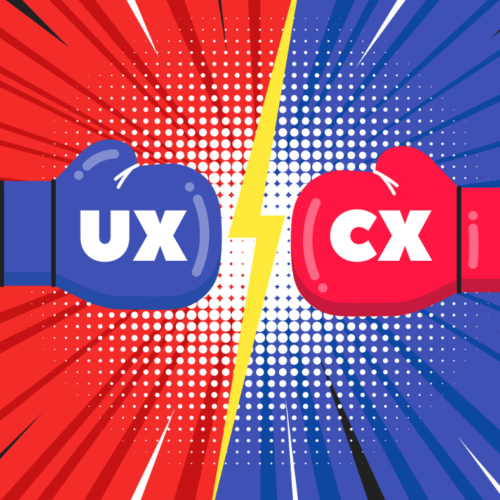
UX (User Experience) refers to the overall experience of a person using a product or service, including how easy or enjoyable it is to use and how well it meets their needs. In market research, UX research helps to understand how users interact with and perceive a product and identify improvement areas.
UX market research is also known as:
- User experience research
- User research
- Human-centered design research
- User-centered design research
- Usability research
- User testing
- User insights
- User-centered research
- Human factors research
CX (Customer Experience) refers to a customer’s overall experience with a company, including their interactions with its products, services, and staff. In market research, CX research is conducted to understand the customer’s perspective of the company and identify areas for improvement to enhance the overall customer experience.
CX research is also known as:
- Customer experience research
- Customer satisfaction research
- Customer insights research
- Customer-centric research
- Customer journey research
- Customer feedback research
- Customer engagement research
- Voice of the customer research
- Customer loyalty research
UX research has been used since the 1980s, when computers became more widespread in everyday life. At that time, the focus was on improving computer software and hardware’s usability and making it more accessible to users.
Get regular insights
Keep up to date with the latest insights from our research as well as all our company news in our free monthly newsletter.
- First Name *
- Last Name *
- Business Email *

CX research has a longer history, as it has been used in the context of customer service and customer relations for many decades. The idea of CX as a key aspect of a company’s brand and marketing strategy became more prominent in the early 2000s as companies began to realize the importance of creating positive and memorable customer experiences.
As technology has continued to advance and customers have become more discerning, UX and CX have become increasingly important in market research. Companies use UX and CX research to gain insights into their customers’ needs, preferences, and behaviors and to create products and services that meet their expectations.
UX and CX are related but distinct concepts in business and market research. UX and CX are both important aspects of business and market research, but they have different goals, focuses, and outcomes. Both are crucial for ensuring customer satisfaction and driving business success.
- Definition: UX refers to the overall experience of a user with a product, including the usability, accessibility, and desirability of the product. CX, on the other hand, refers to the entire customer journey, from initial engagement with a brand to post-purchase customer service.
- Focus: UX research focuses primarily on the design and functionality of the product, while CX research looks at the entire customer experience, including interactions with customer service and the brand.
- Methods: UX research typically involves usability testing, user research, and surveys, while CX research may also involve customer surveys, interviews, and customer journey mapping.
- Goals: The goal of UX research is to improve the design and functionality of the product to create a better user experience, while the purpose of CX research is to improve the overall customer experience and build customer loyalty to the brand.
- Outcome: The outcome of UX research is improved product design and functionality, while the result of CX research is increased customer satisfaction and loyalty.
UX and CX research can be either qualitative or quantitative, depending on the research objectives and the type of data collected.
Quantitative UX and CX research often involve surveys, online polls, and other forms of data collection that generate numerical data, which can analyze and identify patterns and trends.
Qualitative UX and CX research typically involve more in-depth, exploratory methods such as interviews, focus groups, and observation. This type of research is designed to gain a deeper understanding of customers’ thoughts, emotions, and experiences with a product or service.
Brands may conduct UX or CX research to understand their customers better and improve their products or services. Here are some signs that a UX or CX research study may benefit a brand:
- Customer Feedback: If the brand receives a large number of negative comments or complaints from customers about the user experience or customer experience, it may be a sign that a research study is needed.
- Low Customer Satisfaction: If the brand’s customer satisfaction scores are low, it may indicate that there is room for improvement in the customer experience.
- High Customer Churn: If the brand has a high customer churn rate, or if customers are not returning to use their products or services, it may be a sign of a problem with the customer experience.
- Competitor Advantage: If competitors offer better user or customer experiences, research can help the brand understand how it can improve to remain competitive.
- Product Development: If the brand is developing a new product or service, UX or CX research can provide valuable insights into the needs and preferences of the target customer.
Consider the tables below for a smartwatch to show further the differences and parallels in UX and CX market research.
*** Insert Table ***

Examples of UX Research Questions
While there are some similarities in how UX and CX market research is conducted, the questions are often very different.
UX questions help to identify areas for improvement in the product and provide valuable insights into the user experience. The answers to these questions can inform design and development decisions to create a better user experience and improve customer satisfaction.
Here are some examples of research questions that might be asked in a UX market research study:
- How easy or difficult is it for users to navigate the interface of the product?
- How intuitive is the product design and layout?
- How well do the features of the product meet the needs of users?
- Are any areas of the product that could be clearer or easier to use?
- How efficient and effective is the product in performing its intended tasks?
- How satisfied are users with the overall user experience of the product?
- What are the users’ expectations of the product, and how well does the product meet those expectations?
- Are there any frustrations or pain points with the product that users would like to see improved?
- Are there any unmet needs or desires for new features users would like to see added to the product?
- How does the product compare to similar products in terms of user experience?
Examples of CX Research Questions
Conversely, CX research questions help to identify areas for improvement in the customer experience and provide valuable insights into customer needs and preferences. The answers to these questions can inform customer-focused initiatives and drive business success.
Here are some examples of research questions that might be asked in a CX market research study:
- How easily can customers find information about the product and make a purchase?
- How satisfied are customers with the purchase process, including delivery and payment options?
- How well does the company handle customer service inquiries and issues?
- How satisfied are customers with the post-purchase customer service experience?
- How well does the company meet customer expectations for product quality and performance?
- How do customers perceive the brand, and how does this affect their loyalty to the brand?
- What factors influence customer satisfaction with the product and overall customer experience?
- How does the customer experience with the product compare to similar products in the market?
- How well does the company understand and address the needs and preferences of its customers?
- How well does the company handle customer feedback and incorporate it into product development and customer service initiatives?
While UX and CX have different business area focuses, several research methodologies are complementary. By incorporating these complementary areas into UX and CX research, companies can gain a more comprehensive understanding of their customers and users and make informed decisions about product design and customer experience.
These include:
- Brand Research: Brand research focuses on the reputation and perception of a brand, which can impact the overall customer experience.
- Customer Segmentation: Customer segmentation helps to identify different customer groups and understand their needs, preferences, and behaviors, which can inform UX and CX research.
- Voice of the Customer (VOC): Voice of the customer research involves collecting customer feedback and opinions about products, services, and the overall customer experience, which can inform UX and CX research.
- User Persona Development: User persona development involves creating detailed profiles of typical users, which can help to inform UX design and CX strategies.
- Surveys: Surveys can be used to gather data and feedback from customers and users, which can inform UX and CX research.
- Behavioral Analysis: Behavioral analysis involves observing and analyzing user behaviors, which can inform UX design and CX strategies.
- Customer Journey Mapping: Customer journey mapping involves mapping out the different stages of the customer journey and understanding customer needs, preferences, and behaviors at each stage, which can inform UX and CX research.
Why should brands monitor UX and CX collectively?
UX and CX are important to monitor because they play a crucial role in determining the success and competitiveness of a company in today’s market.
Monitoring UX and CX provides several benefits, including:
Customer Satisfaction: Monitoring UX and CX helps companies understand customer needs, preferences, and satisfaction and improve the customer experience to increase customer satisfaction.
Improved User Experience: Monitoring UX helps companies understand user behaviors and preferences and make improvements to the design and functionality of their products to enhance the user experience.
Increased Loyalty and Retention: A positive customer experience leads to increased customer loyalty and retention, which is essential for long-term business success.
Better Business Decisions: Monitoring UX and CX provides valuable insights into customer and user behaviors and attitudes, which can inform better business decisions.
Competitive Advantage: Brands that prioritize UX and CX can differentiate themselves from their competitors and gain a competitive advantage in their market.
Increased Revenue: Companies that invest in UX and CX can increase customer satisfaction and loyalty, leading to increased revenue.
The frequency of UX and CX research can vary depending on several factors, such as the size and complexity of the product or service, the target audience, the research goals, and the research budget available.
For UX research, it is common to conduct user testing and research at crucial stages of the product development cycle, such as during prototyping, before launching a new product or feature, or when making major updates to an existing product. The frequency of UX research can range from one-off studies to ongoing research and testing.
For CX research, companies may conduct studies regularly, such as annually or bi-annually, to track customer satisfaction and feedback over time. This type of research can also be undertaken after key customer interactions, such as after a purchase or customer service interaction, to gather real-time feedback.
In general, it is recommended that companies continuously monitor and gather data on both UX and CX to make informed decisions and improve their products and services over time.
If you would like to improve your user or customer experience, Kadence International would love to assist. Simply, get in touch or submit a research brief.
Helping brands uncover valuable insights
We’ve been working with Kadence on a couple of strategic projects, which influenced our product roadmap roll-out within the region. Their work has been exceptional in providing me the insights that I need. Senior Marketing Executive Arla Foods
Kadence’s reports give us the insight, conclusion and recommended execution needed to give us a different perspective, which provided us with an opportunity to relook at our go to market strategy in a different direction which we are now reaping the benefits from. Sales & Marketing Bridgestone
Kadence helped us not only conduct a thorough and insightful piece of research, its interpretation of the data provided many useful and unexpected good-news stories that we were able to use in our communications and interactions with government bodies. General Manager PR -Internal Communications & Government Affairs Mitsubishi
Kadence team is more like a partner to us. We have run a number of projects together and … the pro-activeness, out of the box thinking and delivering in spite of tight deadlines are some of the key reasons we always reach out to them. Vital Strategies
Kadence were an excellent partner on this project; they took time to really understand our business challenges, and developed a research approach that would tackle the exam question from all directions. The impact of the work is still being felt now, several years later. Customer Intelligence Director Wall Street Journal
Get In Touch
" (Required) " indicates required fields
Privacy Overview
31 Top CX/UX Research Companies for 2019

A Quirk's resource guide covering CX/UX research companies for 2019.

There are many different ways to measure and gauge customer and user experience. Companies that specialize in CX and UX use a range of tools and methodologies – from more traditional methods like surveys to more tech-based techniques like eye-tracking and biometrics – to give insight into how to your users and customers interact with your brand, products and services and provide ways to improve those experiences.
From UX to CX (or both), there are companies ready to provide expertise on how to optimize the way users and customers experience your brand. Whether you need assistance with your customer experience, user experience or both, these companies have the tools and techniques to help.
Founded in 2004 | 100+ employees
Amy Buckner Chowdhry, Founder and CEO

Phone 415-814-9910 www.answerlab.com
ath Power Consulting
Founded 1997 | 60+ employees
Frank Aloi, CEO

Phone 978-474-6464 www.athpower.com
BARE International
Founded 1987 | 500,000+ field force, 350+ dedicated team members worldwide
Dale Bare, CEO

Phone 800-296-6699 www.bareinternational.com
Bellomy Market Intelligence
Founded 1976 | 120+ employees
John Sessions, CEO

Phone 800-443-7344 www.bellomy.com

Founded 1986 | 200+ employees
Fred Ketcho, CEO
Meredith Harper, main client contact

Phone 952-922-2205 www.bestmark.com
Bold Insight
Founded 2018 | 30 employees
Robert Schumacher, Managing Director
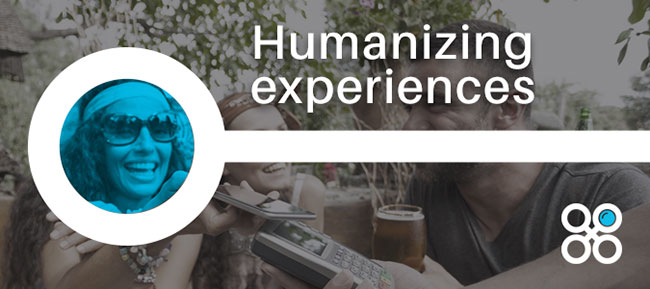
Phone 630-317-7671 boldinsight.com

Branded Research Inc.
Founded 2012 | 15 employees
Matt Gaffney, CEO

Phone 888-848-2525 gobranded.com

Civicom Marketing Research Services
Founded 2000 | 500+ employees worldwide Annie McDannald, Global Manager

Phone 203-413-2423 www.civicommrs.com

Creative Consumer Research
Founded 1976 | 13 full-time; 70 part-time (83) employees
Patricia Pratt, CEO

Phone 281-240-9646 www.ccrsurveys.com
CX analytics solutions
Frank Buckler, Ph.D., Founder & CEO of Success Drivers

[email protected] www.CX-AI.com
The Eidex Group LLC
Founded 1999 | 5 employees
Jeanne Eidex, President

Phone 770-614-6334 www.eidexgroup.com
Focus Pointe Global
Founded 1988 | 480 employees
Laura Livers, CEO

Phone 888-873-6287 www.focuspointeglobal.com
FocusVision
Founded 1994 | 400 employees
Zlatko Vucetic, CEO
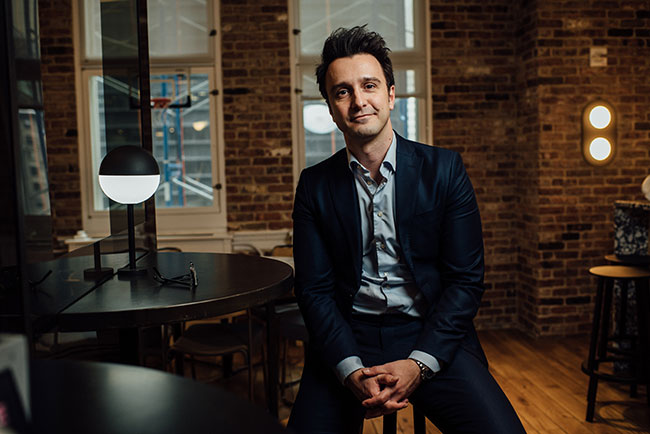
Phone 844-712-6777 www.focusvision.com
Forte Research Group
Founded 2010 | 35 employees Elizabeth Plotkin, VP Insights
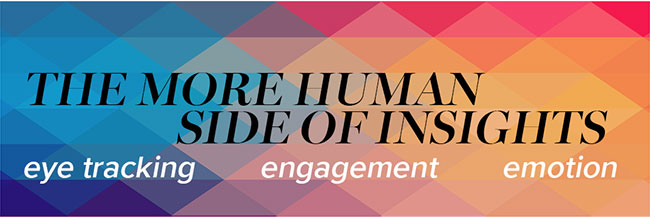
Phone 917-470-9703 www.forteresearchgroup.com

Gold Research Inc.
Founded 2006 | 50 full-time employees, 5,500+ surveyors Nitin Sharma, CEO

Phone 800-549-7170 www.goldresearchinc.com
Infosurv Inc.
Founded 1998 | 12 employees Kyle Burnam, CEO

Phone 888-262-3186 www.infosurv.com/customer-surveys

Interactive Video Productions (IVP)
Founded 1996 | 5 full-time, many contract employees across the globe
Bob Granito, President

Phone 732-970-9446 interactivevideo.com
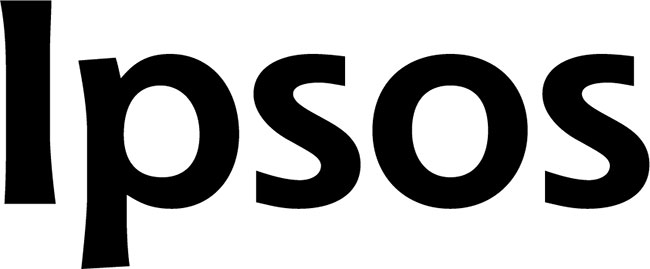
Founded 1975 | 18,000 employees
Didier Truchot, CEO
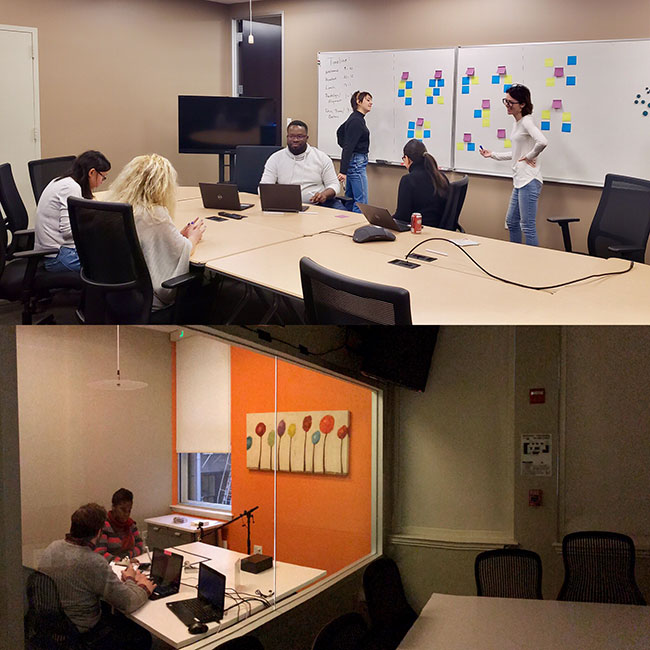
Phone 312-526-4423 | [email protected] https://www.ipsos.com/en-us/ux
LiaCX™ by Intouch Insight
Founded 1992 | 80 employees
Cameron Watt, CEO

Phone 800-263-2980 www.intouchinsight.com/cx
The Martec Group
Founded 1984 | 75 employees Jim Durkin, President

Phone 248-327-8000 www.martecgroup.com
Founded 2006 | 300+ employees Fredrik Östgren, CEO
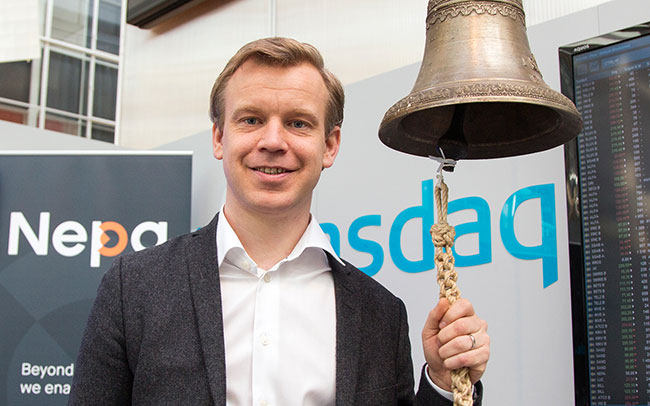
Phone 720-219-4939 nepa.com/customer-experience
Opinions 4 Good (Op4G)
Founded 2010 | 25 employees
Frank Nappo, CEO
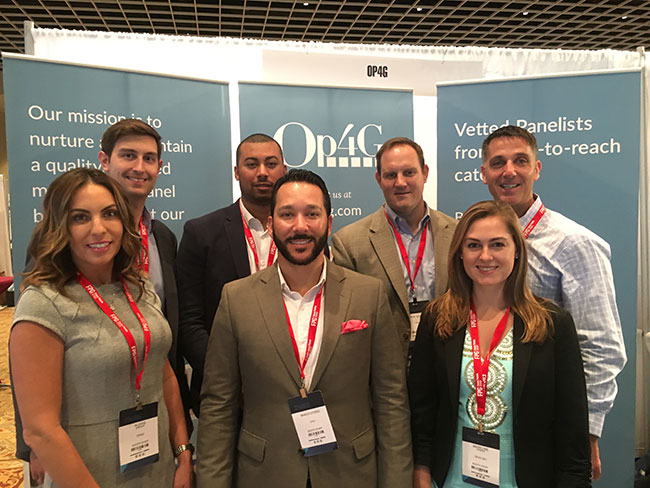
Phone 603-766-5858 www.op4g.com

Perspective Research Services
Founded 1996 | 50 full-time, 1,200+ part-time employees Ivor Stocker, Chairman
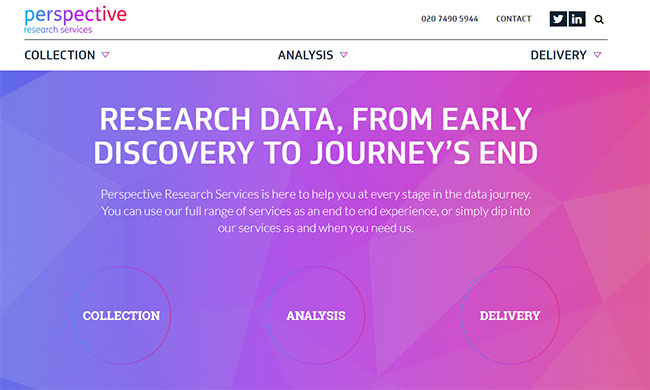
Phone +44 (0) 207 490 5944 perspectivemr.co.uk

Founded 1991 | 30 employees Andreas Noe, Partner, CX Practice Lead and Arnie Guha, Partner, UX Practice Lead

Phone 416-599-7555 x 232 phase-5.com
Precision Research Inc.
Founded 1959 | 25 employees
Scott Adleman, CEO

Phone 847-390-8666 www.preres.com

Founded 2015 | 7 employees
Dexter Chew, CEO

Phone 416-994-0388 www.qone-tech.com
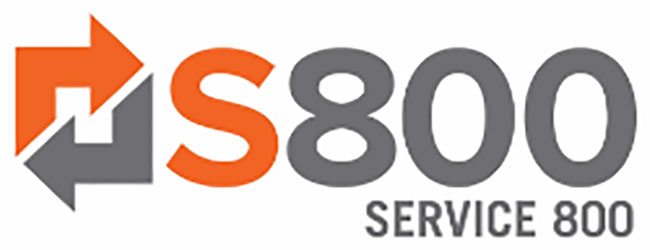
SERVICE 800
Founded 1989 | 107 employees, 385 project professionals
Jean Mork Bredeson, CEO

Phone 800-475-3747 or 952-475-3747 www.service800.com
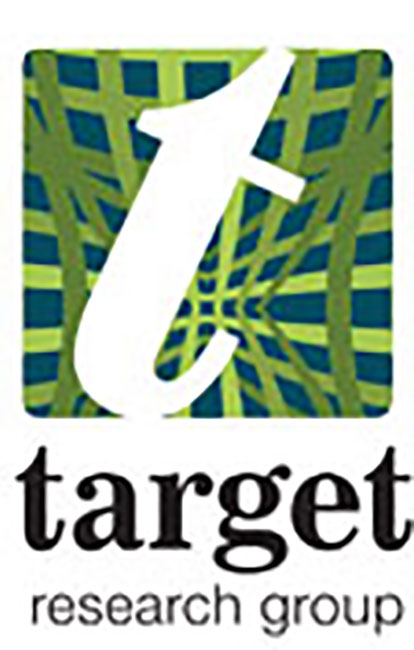
Target Research Group Inc.
Founded 1986 | 26 employees Greg Spagna, CEO

Phone 845-426-1200 www.targetresearchgroup.com
Touchstone Research Inc.
Founded 1991 | 34 employees
Aaron Burch, CEO

Phone 860-335-6079 touchstoneresearch.com

Founded 2007 | 180 employees
Alfonso de la Nuez and Dan Fishback, Co-CEOs
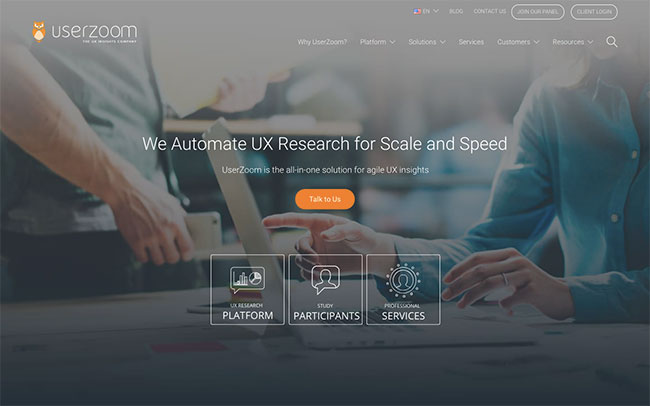
U.S. head office: 866-599-1550 userzoom.com
xsperient | Segmedica
Founded 2004 | 24 employees
Peter Simpson, CEO

Phone 716-799-8223 www.xsperient.com
Visit Consumer Research , Consumer Research Consultation , CX/UX - Customer/User Experience and Consumers for a complete list of companies offering these services.
Tips for elevating yourself and your role as a researcher Related Categories: Consumers, Consumer Research Consultation, Consumer Research Consumers, Consumer Research Consultation, Consumer Research, Research Industry, Communications, Marketing Research Consultation, Strategy Research
How to maximize the benefits and avoid the pitfalls of corporate advocacy Related Categories: Consumers, Consumer Research, CX/UX-Customer/User Experience Consumers, Consumer Research, CX/UX-Customer/User Experience, Research Industry, Brand Identity, LGBTQIA+, Strategy Research
Survey Monitor May/June 2024 Related Categories: Consumers, Consumer Research Consumers, Consumer Research, Research Industry, Grocery/Supermarkets, Restaurants/Food Service, Shopper Insights, Artificial Intelligence / AI, Beverage, Entertainment, Environmental, Health Care (Healthcare), Health Care (Healthcare) Research, Media Research-Digital, Physicians, Transportation, Travel
In Case You Missed It...March/April 2024 Related Categories: Consumers, Consumer Research Consumers, Consumer Research, Beverage, Research Industry, Package Development Research, Packaging Testing, Product Development Research

Customer & User Experience Research (CX/UX Research)
Upcoming Events
CX and UX Researchers bring a combination of empathy and problem solving skills to the task of understanding customer and user needs. Some use surveys, interviews, focus groups and business ethnographies to learn how best to improve a product or service. Others use more specialized techniques to improve the apps, the websites and the technological devices that we use every day.
The faculty in this program will help you to become a unicorn in this exciting industry by training you to observe customers and users systematically and use the necessary technology to enable an organization to respond to what you’ve learned. That’s what we see as the best recipe for a customer driven approach.
Take courses in person or complete your degree completely online. Montclair is ranked #1 in New Jersey and #24 in the nation for Online Colleges!
Job Seekers with a Bachelor’s in fields like sociology, psychology and anthropology are highly valued in this industry because of their interest in people and human behavior. Those with specialized skills in business, computer science and mathematics also possess advantages.
All aspiring CX and UX Researchers can raise their marketability by learning the most current research strategies and the leading software products for experience management solutions like Qualtrics and NVivo. And if your interests are more broad, you can add more data analytical and visualization skills to your resume by learning to use R and SPSS in the Master’s in Social Research and Analysis or the Certificate in Data Collection & Management . Both current students and alumni of the graduate programs in social research & data analysis can also earn this certificate by taking just a couple of more classes.
UX Research: How to Use It to Improve Customer Service
Published: September 30, 2022
Customer experience is a topic we talk about a lot in the customer support field, but UX research isn't typically part of the conversation. Improving the customer experience requires effort from multiple departments, but in this post, we focus on how user experience (UX) research and customer service coexist.

When UX and customer support work together, UX can learn about patterns in customer behavior, usability problems, and customer emotions. If something is a pain for users, customer service reps will know about it and UX researchers can forge a plan to remedy the issues.

In this post, let's review what UX research is and how you can improve your customer service with it.
What is UX research?
Types of ux research, ux research methods, ux research interview questions, ux research tools.
UX research is the study of the user experience on a practical and functional level of product design. UX researchers are focused on making sure products and services are usable so customers can easily meet their goals.
UX research focuses on the functionality of your product/service, and not the holistic view of your brand.
The main difference between customer experience (CX) and UX research is that while CX research might focus on how confident customers are with your customer service, UX research focuses on how successfully those customers can navigate your product and self-service website with a special interest in whether it's easy to use.
This means UX researchers want to study how customers move about on your website, or in your product/app. They're thinking about questions like "What are your customers' behaviors like?" This research might involve using digital observation sessions to see how customers use your tools or you can use surveys to collect user feedback.
UX is a structured, data-driven, research-driven strategy. This type of research usually begins with qualitative methods to determine the user's motivations, and then might use quantitative methods to test the results. Let's dive into the differences between those two types of UX research now.
- Qualitative research: This type of research is focused on attitudes — meaning it's focused on the user's feelings and emotions toward their experience. To gather this research, you'll need to conduct interviews and ask questions, like "Why did you have trouble completing a task?", or "How did you feel while using the product?" Qualitative research can be conducted using methods like interviews, focus groups, diary studies, and open-ended surveys.
- Quantitative research: This type of research is focused on behavioral research methods gathered in the form of numbers and statistics. For UX, this means you measure things like how long it takes a user to complete a task, the percentage of users who completed the task, and how many errors they encountered on the way. With these results, you'll see where users click on a page, and what navigational path they take through your product/app/website. Some methods for quantitative UX research include usability testing, card sorting, A/B testing, evaluations, and analytics.
Now to do this research, you can use several different UX research methods. Let's review those now.
- Usability testing.
- Card sorting.
- Diary studies.
- Interviews.
- A/B testing.
- First click testing.
- Accessibility evaluations.
- Focus Groups
1. Usability testing.
The most common type of quantitative research method, usability testing is when you observe a participant trying to complete a task with your product. This will let you measure how easily people can complete a task, how quickly, what problems they encounter, and if they are satisfied with the process.
Usability testing can also be done remotely, using a platform to record the screen (and voice) and track the eye movements of participants as they interact with your product in their natural environment.
2. Card sorting.
This quantitative research method is commonly used when designing the navigation of a website to help inform information architecture. Card sorting works by having the participants of the research study organize topics into groups that make sense to them, so you can create intuitive and easy-to-navigate web pages.
3. Surveys.
With a survey or questionnaire , you can ask questions to help you with both qualitative and quantitative research. This will help you listen to your customer so you can find new problems, come up with new ideas, and collect feedback from your users.
4. Diary studies.
A diary study is a self-report of a user's activities at regular intervals to create a log of their activities, thoughts, and frustrations. This type of qualitative research takes place over a long period of time. This can help you gather organic feedback on your user's behaviors and experiences using your product in their day-to-day life. You'll find out how often they use your product or service, and why or why not. Plus, you'll learn whether they were able to complete the task or if they experienced frustrations in the process.
5. Interviews.
Similar to surveys and diary studies, you can also interview your users to gain insight into what a user wants from a potential product. If you interview more than one person at a time, this is called a focus group .
These interviews help you observe dynamic discussions and you can observe verbal and non-verbal feedback from your users by asking open-ended questions to uncover details that surveys cannot. This helps you understand your user's feelings and experiences because you can ask follow-up questions and dive deeper into the qualitative research questions.
6. A/B testing.
With A/B testing you can test two different versions of your product to see what audiences prefer. Whether it's a different navigation system or different versions of a landing page. For UX research, this could mean testing various versions of product features, navigation, or self-service website pages.
7. First click testing.
A first click test is when you examine what a user clicks on first when they're on your website and trying to complete a task. This lets you know where their eye is drawn to, and if the logic and navigation all make sense to them.
8. Accessibility evaluations.
An accessibility evaluation will take place to test your design and ensure it's accessible to everyone. How do people with disabilities interact with your design? Are there accommodations for people with disabilities? Accessibility is an important aspect of your customer experience and user experience research.
9. Analytics.
The last type of research method you can use is studying the analytics and metrics via website traffic reports. This will let you know information like traffic, bounce rates, time on page, etc.
At this point, you might be thinking, "What types of questions should I ask a user when conducting UX research?" Let's go over some UX research questions you can ask during an interview.
10. Focus Groups
A focus group is a qualitative research method that lets you have an in-depth conversation with existing, past, or potential users of your product or service. During this conversation, you can hear exactly what the end user thinks of your product in real time.
Focus groups can be done blind, also called a "blind study" for even more accurate results that won't be skewed by brand recognition (or lack thereof).
- What is your first impression of this product/feature?
- What do you think this product/feature does or will do?
- When and where do you think someone would use this product/feature?
- What do you expect to gain from using this product?
- What would keep you from using this product?
- Do you feel this product is similar to another one?
- Do you trust this product?
- You [started to shake your head] when I showed you the interface, what caused this reaction?
- How would you go about performing [task]?
- What do you expect to happen if you did this [task]?
- What alternative method would you use to perform [task]?
- Was anything surprising or did not perform as expected?
- Was the interface easy to understand?
- What was the easiest task to accomplish?
- What was the hardest task to accomplish?
- Do you feel this design was made for you? Why or why not?
- What was the one thing you liked the most about the design?
- What was the one thing you disliked the most about the design?
- If you could change one thing about the design, what would it be?
- Would you download/use this product if the change(s) were made?
- Do you feel this is something for the desktop? Mobile? Or both?
- Would you recommend this to a family member or friend?
Now that you're ready to get started with your user research, you'll probably want some tools to help you get the job done. Below we review some tools you can use at each step of the user research process.
- Survey tools.
- Usability testing tools.
- Card sorting tools.
- A/B testing tools.
- Accessibility evaluation tools.
1. Survey tools.
Survey tools can help you design and format your surveys. They'll help you send your surveys to your audience, whether it's a large or small survey.
UX Research Tools for Surveys
- HubSpot : HubSpot's feedback software takes the guesswork out of customer happiness with customizable surveys, built-in feedback dashboards, and a wide array of feedback methods at your fingertips.
- Qualtrics : Qualtrics XM Platform provides a suite of tools that enable UX researchers to identify gaps and opportunities in their customer experience so that they can focus on building the right solutions.
- SurveyMonkey : SurveyMonkey has built-in solutions to target feedback from employees, customers, potential customers, and other stakeholders of your business. You can choose the reason for your research (marketing, HR, etc.) and build a feedback tool to capture the quantitative or qualitative data you're looking for.
Image Source
2. Usability testing tools.
Usability testing tools will help you capture insight into how your customers use your product. Tools with a video approach will help you observe customers' facial expressions and body language, screen record their experience, and hear their tone of voice. Other tools focus on providing heat maps so you see where the user's eye is drawn and what areas they click on the most.
UX Research Tools for Usability Testing
- UserTesting : UserTesting helps UX researchers target participants for feedback on their products. It can be difficult to source participants without introducing some bias, but UserTesting can reduce the possibility of this happening.
- Chalkmark : Chalkmark specializes in first-click testing that lets researchers identify how users interact with their website, app, and other digital platforms. This tool can measure and help you improve the number of tasks a user can complete after their first click.
- Ethnio : If you already have tools to conduct your research, Ethnio can help you organize them in a research operations CRM.
3. Card sorting tools.
A digital card sorting tool will provide a platform where you can have users drag digital cards to different categories. This will help you learn whether the names and categories of products are understandable and match your customer expectations.
- OptimalSort : OptimalSort gives you a front row seat into how people organize and categorize information. This inight helps UX researchers make decisions about product architecture.
- Maze : Maze is one of the fastest ways to get customer-centric insights on wireframes, content, copy, and customer satisfaction. You can choose from a variety of eight tests, notable ones include prototype testing, tree testing, and the 5-second test.
- UserLytics : In a simple, 4-step process, UserLytics can improve your user experience. You can use the platform on its own, or incorporate professional services like test plans, moderation, and analysis into your workflow to get the best insights possible.
4. A/B testing tools.
Most marketing automation tools offer an A/B testing tool that will allow you to test different versions of an email, web page, or landing page.
UX Research Tools for A/B Testing
- HubSpot : You can run A/B tests on your web pages using HubSpot's "Run a test" feature. After analyzing the results, deleting the lower performing variation can be done in just a few clicks.
- FreshWorks : If you're looking to test multiple variations of a landing page, try Freshworks. It enables audience segmentation and revenue optimization features to help you get accurate measurements of the impact of your test.
- Optimizely : Optimizely offers researchers to run A/B tests without compromising other aspects of the user experience like site speed. By using a CDN to process images and other content, your A/B test results won't be skewed by an additional variable.
5. Accessibility evaluation tools.
An accessibility evaluation tool will review your website and let you know if it meets accessibility standards.
UX Research Tools for Accessibility
- DynoMapper : DynoMapper incorporates local and international accessibility guidelines in it's testing platform so that you can test for known and potential issues on your site.
- Remediate : Run automated accessibility checks using Remediate. It includes WCAG Guidelines, schedule testing, and re[air recommendations so you don't have to guess the best way to improve your site — you can rely on quality data.
- TPGi : TPGi is a free tool that scans five pages of your site on a monthly basis. It looks for potential issues and offers remedies.
Improving Customer Experience with UX Research
Continued collaboration between customer support and UX researchers will help both teams achieve the same goal: a more positive customer experience that results in fewer questions and provides immediate value for your customers. UX researchers should regularly keep in touch with customer service as they have incoming customer feedback on a regular basis with a gold mine of user expectations.

Don't forget to share this post!
3 templates for conducting user tests, summarizing UX research, and presenting findings.
Service Hub provides everything you need to delight and retain customers while supporting the success of your whole front office
- Downloadables
Start Your Research
- Join a Focus Group

Consumer Experience and User Experience Research
Providing support services for consumer and user experience testing, allowing you to focus on understanding user needs while we handle logistics, ultimately creating exceptional user experiences.
Streamline UX Testing with Fieldwork
Your trusted research partner.
We understand that achieving optimal user experience requires a deep understanding of user behavior, needs, and motivations. However, navigating the logistical challenges of UX testing research can be overwhelming, from participant sourcing to security measures. As experienced researchers and market research vendors, we become your truly helpful partners, anticipating your needs based on our industry experience and expertise.
Request a Quote

Location Flexibility
Unmatched flexibility, allowing you to conduct research at your preferred location – your lab, our cutting-edge facilities, or anywhere in between.
User Screening
Our rigorous verification process prioritizes confidentiality, anonymity, and data integrity, utilizing multi-touch approaches and phone confirmations to ensure reliable participants.
Robust Security Measures
We prioritize stringent management of non-disclosure agreements (NDAs) and informed consent forms (ICFs), safeguarding sensitive health information and proprietary data with strict adherence to industry standards.
Specialized Testing Expertise
Our extensive participant network includes elusive demographics, providing a diverse and representative sample for your study.
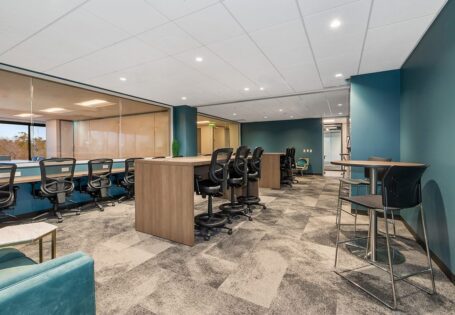
The Process
Supporting Your Important Research
With no detail left behind.
In user testing – every detail matters. From ensuring the right users are secured, to keeping details blinded for security best practices, nothing can be missed. Project success starts in the planning stage, from recruiting specific quotas to preparing an environment to effectively collect research from users.
Our streamlined process ensures efficient execution of your research objectives, providing you with an environment and users to gain valuable insights to enhance the customer and user experiences.
You have a UX/CX research project that could use support (recruitment, venue, project management, or a combination!).
Reach out to Fieldwork with your project details. You can expect a collaborative engagement to determine pricing and feasibility.
When you are ready to confirm your project with Fieldwork, please send final specifications, dates and a schedule to your dedicated project manager.
Throughout recruitment, your single point of contact will deliver daily updates, consumable on the go. Each persona profile is vetted for data quality and goes through our Multi-Touch Process.
Whether we’re hosting you at our venue, setting up at yours, or meeting you somewhere in between, the Fieldwork team handles on-site logistics to ensure your day runs smoothly.

Want to Participate in Research?
Impact the Products and Services You Use Daily
Be a part of shaping the future by participating in online or in-person focus groups.
Sign Up to Participate
Additional Support
A Guide to Consumer Experience and User Experience Research
Unlock the key elements that define exceptional user and customer experiences! Explore the transformative potential of collaborating with the right research facilitation, participant recruiter, and focus group/venue partner to maximize the impact of your studies.
Download the Resource
From recruiting to facility and hosting, everything was excellent!
Supporting cx/ux research.
Expand your research resource library! In our blog, the Fieldwork team shares experience-backed advice alongside contributions from industry experts.


9 Must-Ask Questions To Ensure Security And Privacy For Ux Testing Outside Your Facility
UX research is an important tool for businesses that want to create high-quality products and services that meet the needs and expectations of their users. In fact, when UX research is done right, the return on investment can be as high as 301%.

Best Practices For Ux Research With Kids
Childhood experiences between generations are vastly different, but understanding why that is and how that matters when evaluating consumer opinion is the business of Rebecca Presler, Senior Qualitative Researcher and Strategist at MLN Research.

UX Design For Wearables: Working With A Recruitment Partner
Wearable technology has become an integral part of our daily lives, with the demand for these devices on the rise. Whether it’s fitness trackers, smart jewelry, or blood pressure monitors, wearables are becoming increasingly sophisticated, and as such, their user experience (UX) design needs to evolve accordingly.

Empower Your Research with Fieldwork
Let Fieldwork support you in your journey to create user experiences that are seamless, efficient, and intuitive.

WE HELP YOU CREATE
Irresistible User Experiences
TESTIMONIALS

The user experience you offer customers is critical for developing and maintaining brand loyalty. Our user research consulting expertise can help you get a better handle on how your UX is and isn’t building a stronger bond between you and your market.
Whether your in-house team lacks the necessary background, you want to root out the biases in your own research or you’re looking for more meaningful ways to spread insights throughout your organization, our UX design consultants can point you in the right direction.
CX/UX Strategy
Create your long-term customer experience strategy.
User Research
Inform strategy through qualitative and quantitative user experience research studies.
UX/UI Design
Create and validate user centered designs.
Customer Journey Mapping
Understand, track & prioritize customer journeys with JourneyTrack.
Competitive Insights
Get industry-specific Mobile UX competitive intelligence.
EmTech Strategy
Years in business, industries we serve, fortune 500 clients, key lime proven process.
To ensure that we always deliver high-quality and trusted outcomes, Key Lime Interactive employs a proven process with each engagement. This ensures that you know what’s next, you know the best ways to communicate often with our team, and you understand the direction of the outcomes before you receive them so that you’re always satisfied and prepared for action.

Why Choose Us
Actionable insights that keep pace .
Receive fast-track insights you need to make smarter product decisions. Accelerate growth and engagement with Key Lime research and our proprietary tools and processes including Competitive Insights and JourneyTrack .
DEI Index at Your Fingertips
We created our proprietary Inclusivity Index to help make it easier for companies to understand how they can strive to be more inclusive through their research, brands, products, and services.
Diversity is in our Roots
The diversity of lived experiences of our people are our greatest trade secret and it’s reflected in the integrity of insights we'll deliver to you and brands around the world.
We are Global
As a founding members of the UX Fellows Alliance with over 26 locations around the globe, we'll support your global needs.
How to Get Started
Meet with a kli team member.
Schedule a time to discuss your current project and UX needs with a Key Lime Interactive user experience consultant.
Get Actionable CX/UX Insights
Next, our UX consultants will propose a project scope that includes how we’ll handle the research methodology, the participants, and recruitment for you.
Make Smarter Business Decisions
You’ll receive a high-level report containing all the CX/UX research insights, any survey responses or recordings, Q&A’s and our recommendations.
"...your contributions to [the project] have been invaluable and provided us with the most comprehensive feedback from real users we’ve had in a while. Thank you for helping us lay the framework for great things ahead: we couldn’t have done it without you! Thank you for everything!"
Senior Researcher / Google
"I’ve really enjoyed working with [Key Lime Interactive]. [They] did great work recruiting, organizing, fielding, synthesizing and keeping the project headed in the right direction. I hope we get another opportunity in the near future."
Head Researcher / Bose Corporation
"My VP...emailed me, my manager, my managers boss, and even his boss, saying how impressed he was with our study, presentation, report. That's huge. Big time kudos! Great job!"
Staff Researcher / Roku
"I'm reading through the final report for the Express Checkout study and I wanted to pause and let you know that your reports get better and better. This is the best final report of all of them over the last few years. The information displayed is awesome. You should be proud of your team!"
UX Architect / Southwest Airlines
"Great job .... Well done again! Thank you for running an excellent study and for delivering this report ahead of time. I’m reviewing it now and there are several suggestions that seem to be spot-on."
Design Lead / Cisco

Key Lime Interactive
Privacy Policy
8350 NW 52nd Ter. | STE 301 Doral, FL 33166
155 Water St. | UNIT 3/12 Brooklyn, NY 11201
Masterclasses
Subscribe to Our CX Newsletter

What is a UX Researcher? The Ultimate Guide for 2024

The role of the user experience (UX) researcher is becoming more prominent, more specialized, and more in demand.
Uncovering user behaviors, needs, and motivations in order to design products and services that provide value is the crux of user experience research. When performed correctly, these methods have a huge impact on business.
So what is a UX researcher?
In this guide, we’ll take a look at what a UX researcher does and the UX research career path.
Although there is no singular path, there are four main steps to move a UX researcher forward: expanding knowledge of the user research field ; obtaining foundational skills ; crafting a portfolio; and building a network of industry peers.
Here’s what we’ll cover:
- What is a user experience researcher?
- What does a user experience researcher do?
- What skills are required for a career in UX research?
- How to expand your knowledge of the UX research industry
- How to obtain the necessary foundational skills
- How to craft a convincing portfolio
- How to build a solid network of industry peers
- Final thoughts
1. What is a user experience researcher?
A user experience researcher has their hand on the pulse of user needs and goals. They are the empathetic, organized, critical thinker whose day-to-day is about the first stage of the design thinking process : empathize .
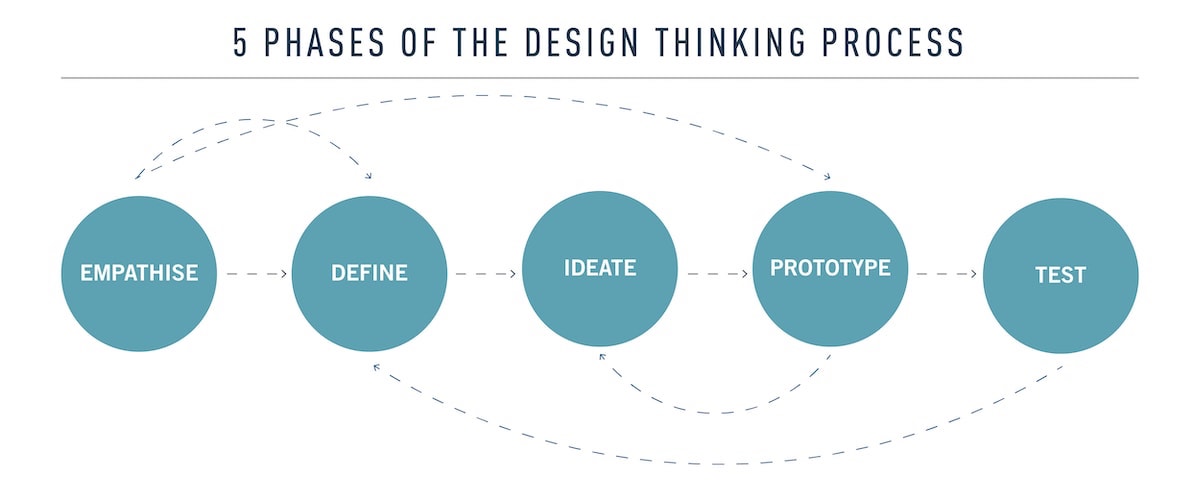
This isn’t to say that UX researchers’ work is totally separate from the rest of the process, but their work has arguably the most humanizing effect on the process. Here’s why— UX researchers know how to:
- Understand the problem or challenge at hand
- Apply a variety of methods and approaches to finding out how their users tick in the context of this problem or challenge
- Listen, observe, and ask the right kinds of questions to gather insights that can be turned into actionable ideas
- Synthesize their findings and communicate them to the rest of the team and to key stakeholders in clear, actionable, and even engaging ways
2. What does a user experience researcher do?
The purpose of the UX researcher (also referred to as “user researcher” or “design researcher”) is to unearth human insights in order to guide the application of design.
According to a recent job posting by IBM, as a design researcher, you will “help provide actionable and meaningful data-driven insights that represent the voice of multiple users. You will collaborate across development, design, and marketing teams to evaluate current and upcoming user research needs that help to improve product definition and drive business goals.”
Some typical tasks and responsibilities of the UX researcher include:
Research Planning and Recruitment
- Develop a well-crafted research plan with clear research objectives.
- Write usability research screeners and discussion guides.
- Recruit targeted end-users for specific research studies.
Data Collection
- Moderate one-on-one basic usability sessions.
- Help develop and implement quantitative surveys.
- Conduct stakeholder and client interviews .
Data Analysis
- Extract insights about user behaviors from web instrumentation tools.
- Translate user insights into actionable recommendations for the product team.
Presentation of Insights
- Craft personas and other “information radiators” (e.g. journey maps) to communicate insights across the design and development teams.
- Present design research findings to the larger team in a clear and organized fashion.
- Work closely with the product team to identify research objectives.
- Establish and implement an overall research strategy.
These are just a handful of tasks that belong to UX research. Ultimately, your job as a UX researcher is to build up a picture of your target users based on their needs, wants, motivations, and pain points. These insights enable the wider design team to create user-friendly products based on real user feedback—not just your assumptions.
As with most UX design roles, the UX researcher means different things to different companies.
To learn more about what might be expected of you as a UX researcher, browse various job sites and see how different companies advertise and describe the role. Here are some useful job portals to help you get started:
- UX Jobs Board
- Just UX Jobs
- User Experience Professionals Association
- AIGA Design Jobs
3. What skills are required for a career in UX research?
Now we’re familiar with some of the key tasks and responsibilities, let’s consider what skills are required for a career in UX research.
As such, being a UX researcher typically requires knowledge or experience in a relevant field that studies human behavior, such as cognitive science, behavioral economics, anthropology, sociology, or psychology. Ultimately, it’s important to be adept at reading people and empathizing with the user, and equally at home handling data and analytics.
Ideal candidates are typically “passionate, curious, and self-driven team players” who have experience working in fast-paced environments while applying both generative and evaluative research methods to build a larger understanding of users.
It’s also important to have a solid understanding of the design thinking process, as well as a passion and know-how for influencing design strategy.
Obtaining these skills can be done through identifying research opportunities with a current employer, volunteering for a design project with an external organization (e.g. VolunteerMatch), or completing research for a personal project of your own.
Overall, practice makes perfect, and refining these skills as often as you can prepare you for your future role. You can even get a design thinking certification by taking a course or program in the discipline, to show potential employers and clients that you truly know your stuff.
4. How to expand your user research knowledge
As already mentioned, there are four key steps to forging a career in UX research:
- Expand your user research knowledge.
- Obtain the foundational skills.
- Craft a portfolio of experience.
- Build a network of peers.
Let’s start with that first step: Expanding your knowledge of the UX research field. In addition to browsing job descriptions, there are plenty of things you can do to learn more about the industry — but where to begin?
Start with the basics and learn all about UX design in this comprehensive guide , and understand the critical role UX research plays in UX design in this article.
From there, learn about the difference between qualitative , quantitative , attitudinal, and behavioral research. Next, you can familiarize yourself with some common UX research methods, such as card sorting, usability testing, and user interviews.
You’ll find an introduction to some of the most important UX research methods on the CareerFoundry YouTube channel (and be sure to take a look at these free UX research tutorials ).
Be sure to watch the video below, in which CareerFoundry graduate and professional UX designer Maureen Herben explains the different techniques and tools used in qualitative user research:
As part of your own research into the UX research field, you’ll also want to consider things such as salary and career options. Sites like Glassdoor and Payscale provide up-to-date salary reports for a range of different locations.
If you can, reach out to people who are already donning the UX researcher job title. Do they tend to work remote or in-house? What kinds of companies employ UX researchers? Again, job sites can help you out here if you don’t have any contacts in the industry (yet!).
Before you commit to the UX researcher route, it’s important to learn as much as you can about the industry and what the role entails.
5. How to obtain the foundational skills necessary for a career as a UX researcher
If you’re keen to forge a career in UX research, you’ll need to start learning some of the key skills. As with any profession, it’s important to build a solid foundation of knowledge before jumping into real-world problem-solving.
Assuming that you already have some knowledge in a related area (cognitive science, sociology, psychology, etc.), there are plenty of ways to learn the fundamentals of user research. Let’s consider those now.
- Human-Computer Interaction: An Empirical Perspective : learn about the foundational topics about one of the precursors to UX design. As well as being a neat introduction to HCI , this book includes historical context, the human factor, interaction elements, and the fundamentals of science and research.
- User Research: A Practical Guide to Designing Better Products and Services : learn about all the key research methods including face-to-face user testing, card sorting, surveys, and A/B testing.
Online resources
Industry blogs are a great way to start learning the ins and outs of the field. Some useful (and trustworthy!) sources include:
- Nielsen Norman Group
- UX Collective
- Inside Design
Conferences and meetups
If possible, consider attending a UX research conference or a local meetup. You’ll find a list of the top UX research conferences to attend in 2019 here , and can search for local UX research groups on meetup.com .
In addition to the examples above, finding an apprenticeship or a more senior researcher who is willing to let you shadow their process is a great way to immerse yourself in the context of a UX researcher while learning “on the job.”

6. How to craft a convincing UX research portfolio
As with any design role, a compelling portfolio is key to proving you’ve got the right skills for the job. So how do you go about creating a convincing UX research portfolio ?
As you practice refining your skills, keep a record of your work to present to future employers. Crafting an online portfolio is a great supplement to a resume or CV when highlighting case studies that show hiring managers what you can do. According to Senior UX Recruiter Tom Cotterill:
“Your portfolio should show cultural suitability for the company where you are applying. Don’t be afraid to add a touch of character or your own style to your portfolio. It’s your chance to wow the hiring manager and demonstrate that you stand out from the crowd. A good portfolio indicates, in short, that this person has taken time to represent themselves in the best possible light, and they’re clued up enough to showcase their most relevant work in an aesthetic and logical way.”
Ultimately, your portfolio should include the following sections:
- The problem or design challenge your research aimed to solve.
- The team you collaborated with.
- The research process (how did you go about solving the problem?).
- The tools you used to recruit, collect and analyze data, and present insights.
- The final outcome and the handoff of the design for development .
For more insight on how to refine a great UX research portfolio, check out How to Wow Me With Your UX Research Portfolio and How to Create a Powerful Case Study for Your UX Portfolio . Another great resource for inspiration is Bestfolios , the largest curation of best UX research and designer portfolios, resumes, case studies , and design resources.
7. How to build a network within the UX research industry
You’re in the process of mastering the right skills and crafting your portfolio. Now it’s time to network! Networking is one of the best ways to meet people in the UX field and potentially land a new job.
Let’s consider some of the best opportunities for making industry connections.
Current Co-Workers
If you are currently employed, look to see if there are any user experience researchers in your organization, and ask them what it’s like! Also request to shadow them during a research session and take notes.
Future Employers
Informational interviews are also a great way to get candid feedback with people working at great companies, such as IBM, Google, or Amazon. Using LinkedIn or Twitter to find and invite UX researchers for coffee is a solid way to get an idea of what it may be like to work for your company of interest, and also how to get in the door.
Online UX Communities
Actively participate in online UX communities (e.g. Facebook groups) relevant to your professional interests and learning goals. Here are a few to start with:
- Useful Usability
- The UX School
UX Research Organizations
Lastly, join 1-2 user experience research organizations, such as the User Experience Research Professionals Association or the Design Research Society to see if there are any upcoming events you can attend.
8. Final thoughts
UX is a growing field, and the role of the user experience researcher is becoming more and more pivotal. Equipping yourself with the necessary skills and knowledge, and learning to conduct UX research like a professional , while surrounding yourself with peers in the field who you can learn from are essential to becoming a UX researcher yourself.
Overall, the value of understanding the needs of the customer cannot be ignored, and user experience researchers will have an increasingly valuable role to play in the future of design.
If you’d like to learn more about UX research, check out the following guides:
- What is the UX research salary?
- A 5-Point Roadmap For Any UX Research Project
- How to conduct a UX audit
- Top 5 Mistakes to Avoid in Your UX Research Portfolio
- Interview Toolkit: Top 5 UX Research Questions to Prepare For
Market Research vs UX Research: The Definitive Guide (2024)

Market research vs UX research: What’s the difference? It’s a common question. This is especially the case amongst founders looking to explore new market and product opportunities. And with global spending on CX estimated to reach $640 billion in 2022, it’s no wonder CEOs want to get their head around these terms.
There are many similarities between market research and UX research. So much so, that the terms are occasionally used interchangeably. At their core, both research types focus on the customer experience. That said, there are also some key differences in their applications and business goals.
Read on to discover the similarities and differences between these two types of research. Plus, we’ll look at how to integrate them for better business results.
Definitions: Market research VS UX research
Let’s dive right in with some definitions.
What is market research?
Market research is the process of learning about customers’ needs and buying preferences. The goal is to determine whether a product is worth launching .
Market research utilizes large-scale surveys and data analysis to define a market for a product, narrowing it down to a specific audience that is most likely to buy your product. In doing so, your business can determine if a product is worth launching or not. What’s more, companies use this information to create targeted ads and messaging to connect with the target demographic.
While Steve Jobs may have famously not been a fan of market research, the industry’s global revenue exceeded $76.4 billion in 2021. That’s over double since 2008.
What’s UX research?
UX research is essentially a methodical study of users designed to inform and improve a product team’s decision-making . This empowers teams to be more user-centric and actionable.
UX relates to the in-product experience, falling under the umbrella of customer experience (CX) . Interestingly, better UX design can yield conversion rates of as much as 400% .
UX research employs qualitative and quantitative research methods to uncover:
How customers use a product
What issues users experience
Where the product isn’t meeting users’ needs
UX experts use the results to come up with design solutions that must then undergo iterative testing. As a result, your business can improve common issues, such as high drop-off rates, low customer satisfaction scores, or other usability complaints.
UX research focuses on getting to know an existing audience better. That information is then used to tailor the product to make it more desirable to the target demographic.
Although UX principles can be applied to any product, UX is most typically associated with software. Conversely, market research can be applied to any product; physical or software.
Recap: Both market research and UX research form a specific (and equally important) part of the product development and design process:
Market research → focused on understanding buying behaviors and preferences
UX research → aims to understand how users interact with a product .
Put another way, market research tells you who your audience is and UX research reveals how to make the product more desirable to them.
When to carry out market or UX research
Now let’s talk about when these research types are used.
UX research is almost always applied when there is at least a rudimentary prototype ready for user testing. Having said that, it’s technically possible to carry it out without having a product.
We’ll elaborate.
Since there’s a broad spectrum of research methods, UX research can be carried out throughout the full product development life cycle.
In contrast, market research almost always precedes a product launch or major update.
Summing up: Market research is typically done before a product launch or update. UX research, on the other hand, can technically be carried out throughout the product development cycle.
Market Research vs UX Research: Applications and goals
Do you remember when we said there were some differences in the application of market research vs UX research? Good. Here’s a closer look.
We’ve broken down our process when conducting each type of research.
Market research
Generally speaking, market research focuses on understanding purchasing behavior and user preferences. Put simply, it’s oriented toward selling products to customers. During market research, we want to answer the following 3 questions:
Is there a market need for the product?
Who would buy the product?
How can you reach the target buying audience?
In essence, market research uncovers the viability of the product, informing the market strategy your business should take.
During market research activities, we recommend focusing on:
Market size
Defining pricing
Market trends
Testing concepts
Gauging competition
UX research
As we know, UX research studies users to gain insights into their needs, expectations, and behaviors. In other words, the interaction between users and products. Generally speaking, UX research should aim to answer 3 key questions:
What do users want?
What do users need?
How do they use your product?
During the UX research process, the goals are:
Define personas and user journeys
Understand users’ needs and goals
Identify bottlenecks in the user journeys
Test the potential for new features
Pinpoint optimal information architecture & onboarding
Determine areas for experience improvements
Compared to market research, UX research is carried out on a much smaller scale. In fact, the majority of usability issues can be identified in test groups with just 5 or 6 participants.
Review: As you can see, we have very different purposes for each research type. For instance, market research tends to look outwards (market, competitors, etc,). Meanwhile, UX research typically looks inwards at the product itself. That said, the end goal remains very similar; build an incredible customer journey .
Market research vs UX research methods
Now let’s get back to the similarities between these two types of research.
Both market and UX research use practically identical research methods. These include:
Focus groups
Personal interviews
Observation & Field trials
Competitive research
A/B testing
Let’s be clear, though. Despite these methods being almost identical, the context that we apply them to is different.
This brings us back to goals.
Market research leverages the methods above to determine how marketable and viable a product is for the business. By contrast, a UX researcher employs the same methods to learn about and analyze user behavior .
Despite sharing many research methods, some are more commonly used for a specific type of research. For instance, UX research utilizes techniques such as usability testing , heuristic evaluation , and eye tracking .
While these methods are part of UX research, the insights uncovered may be valuable for the market research team too.
Here’s an example.
Let’s say your UX research uncovers the potential for a new product or feature. Market research will help you gain deeper insights into that opportunity. As such, they are still tightly connected.
Similarly, certain activities like social media listening and analyzing sales data are generally better suited to market researchers. However, they may also be employed by UX researchers to understand the interaction between the customer and product better. In short, there is a strong overlap between the tactics used for both market and UX research.
The bottom line: Market and UX research share a plethora of identical research methods. Even though there are some methods that are better suited to a specific research method, a strong overlapping remains. Therefore, there are no clear lines of separation between the methods used for each.
Market research vs UX research: Which do I choose?
Unsure which type of research is best for your business? We suggest first identifying the business problem you want to solve.
Let’s say you have launched a new product.
Despite being marketable, it is still not fulfilling business goals. In this case, UX research will help you better understand how your customers are interacting with your product. As such, you’re more likely to get the answers you’re looking for.
Now let’s imagine a different scenario.
If your business has concerns over the marketability of your product, market research will deliver the answers you need.
Here’s our two cents.
At Adam Fard, we don’t really differentiate between market and UX researchers. Instead, our researchers both integrate research types for more holistic insights.
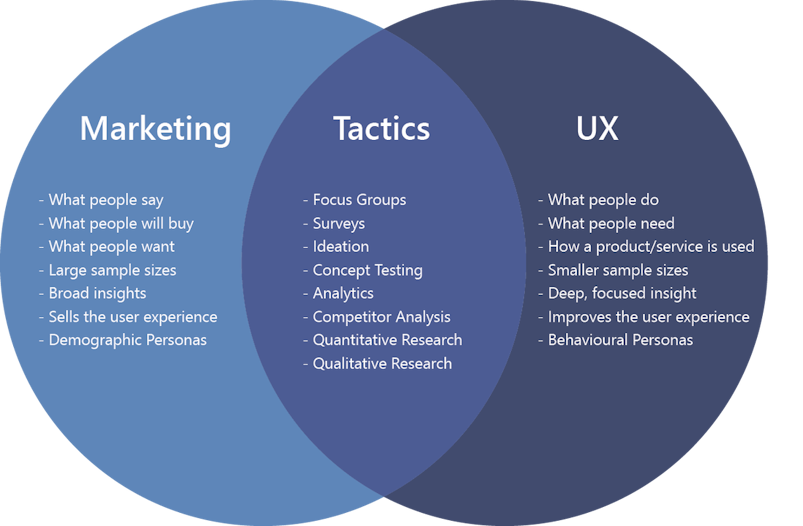
Integrating UX & Market Research
As we’ve just seen, there is a huge overlap between these two types of research. As such, it doesn’t always make sense to have a wall between the two activities. In fact, doing so can result in an inefficient workflow with a sub-par result.
Here’s why.
Firstly, separating market and research will lead to duplicating work. Since there are so many similarities, it’s highly likely that your teams will carry out the same subactivities twice.
More importantly, allocating one part of the research process to marketers and the other to design experts disjoints the customer journey. As a result, the overall customer journey will lack cohesion. Considering 89% of businesses compete primarily on the basis of customer experience (CX), this is a risky move.
Things are changing.
The research landscape is evolving rapidly. In fact, the Walker 2020 Progress Report forecasted that customer experience would become the key brand differentiator by 2020. As such, businesses can no longer rely on clever marketing or low pricing to win over customers. Instead, they need to offer customers a thoughtfully-designed product that is seamless to use.
This evolution in research has seen an even bigger overlap between market and UX research. UX research opens the doors to a deeper understanding of your customers’ engagement with your product. By finding this out, your business can pinpoint where it needs to invest its energy and where it is succeeding.
The Roundup
We hope this has given you a better understanding of market research and UX research and the benefits to your business. Both market and UX research form vital parts of the design and development process. Although they are almost identical in some ways (research methods, business objectives, etc.), they approach business problems from different angles. As such, we believe integrating both research types offers better holistic insights.
Don't forget to share this post:
Need help with UX research?
We can help resolve Usability, Retention Rate and Conversion issues:
Related Stories
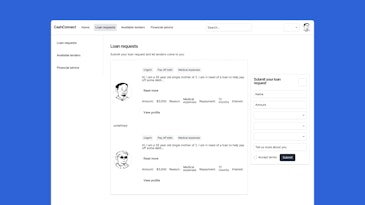
Generate Wireframes in Figma with UX Pilot AI
Discover how UX Pilot AI transforms simple text prompts into detailed Figma wireframes in seconds. Tired of the endless sketching and revisions? See how UX Pilot's unique approach allows unlimited creative freedom, perfectly aligning with any design vision.
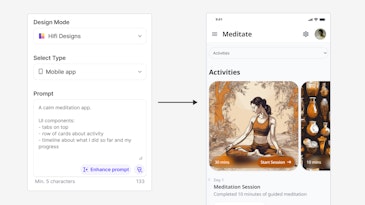
Generate UI designs in Figma with AI
A step-by-step process to turn a simple text prompt into a hi-fi design in a matter of seconds, using AI
Does UI Design Matter? An Essential Guide for UX Designers
Is UI design the key to user engagement? Discover what experts have to say and case studies in this essential guide. Master the balance between aesthetics and functionality to improve user experience and elevate your design projects. Perfect for UX designers looking to innovate.
Exclusive UX Articles & Strategies
for Startups, UX Designers & Entrepreneurs
- Vitaly Friedman
- May 7, 2024
How To Run UX Research Without Access To Users
- UX Research , User Experience , Design
- Share on Twitter , LinkedIn
About The Author
Vitaly Friedman loves beautiful content and doesn’t like to give in easily. When he is not writing, he’s most probably running front-end & UX … More about Vitaly ↬
Email Newsletter
Weekly tips on front-end & UX . Trusted by 200,000+ folks.
UX research without users isn’t research . We can shape design ideas with bias, assumptions, guesstimates, and even synthetic users , but it’s anything but UX research. Yet some of us might find ourselves in situations where we literally don’t have access to users — because of legal constraints, high costs, or perhaps users just don’t exist yet. What do we do then?
Luckily, there are some workarounds that help us better understand pain points and issues that users might have when using our products. This holds true even when stakeholders can’t give us time or resources to run actual research, or strict NDAs or privacy regulations prevent us from speaking to users.
Let’s explore how we can make UX research work when there is no or only limited access to users — and what we can do to make a strong case for UX research .
This article is part of our ongoing series on design patterns . It’s also an upcoming part of the 10h-video library on Smart Interface Design Patterns 🍣 and the upcoming live UX training as well. Use code BIRDIE to save 15% off.
Find Colleagues Who Are The Closest To Your Customers
When you don’t have access to users, I always try to establish a connection with colleagues who are the closest to our customers . Connect with people in the organization who speak with customers regularly, especially people in sales, customer success , support, and QA. Ultimately, you could convey your questions indirectly via them.
As Paul Adams noted , there has never been more overlap between designers and salespeople than today. Since many products are subscription-based, sales teams need to maintain relationships with customers over time. This requires a profound understanding of user needs — and meeting these needs well over time to keep retention and increase loyalty.
That’s where research comes in — and that’s exactly where the overlap between UX and sales comes in. In fact, it’s not surprising to find UX researchers sitting within marketing teams under the disguise of Customer Success teams, so whenever you can befriend colleagues from sales and Customer Success teams.
Gaining Insights Without Direct Access To Users
If you can’t get users to come to you, perhaps you could go where they are. You could ask to silently observe and shadow them at their workplace. You could listen in to customer calls and interview call center staff to uncover pain points that users have when interacting with your product. Analytics , CRM reports, and call center logs are also a great opportunity to gain valuable insights, and Google Trends can help you find product-related search queries .
To learn more about potential issues and user frustrations, also turn to search logs, Jira backlogs, and support tickets. Study reviews, discussions, and comments for your or your competitor’s product, and take a look at TrustPilot and app stores to map key themes and user sentiment. Or get active yourself and recruit users via tools like UserTesting, Maze, or UserInterviews.
These techniques won’t always work, but they can help you get off the ground. Beware of drawing big conclusions from very little research, though. You need multiple sources to reduce the impact of assumptions and biases — at a very minimum, you need five users to discover patterns .
Making A Strong Case For UX Research
Ironically, as H Locke noted , the stakeholders who can’t give you time or resources to talk to users often are the first to demand evidence to support your design work. Tap into it and explain what you need. Research doesn’t have to be time-consuming or expensive; ask for a small but steady commitment to gather evidence. Explain that you don’t need much to get started: 5 users × 30 minutes once a month might already be enough to make a positive change.
Sometimes, the reason why companies are reluctant to grant access to users is simply the lack of trust . They don’t want to disturb relationships with big clients, which are carefully maintained by the customer success team. They might feel that research is merely a technical detail that clients shouldn’t be bothered with.
Typically, if you work in B2B or enterprise, you won’t have direct access to users. This might be due to strict NDAs or privacy regulations , or perhaps the user group is very difficult to recruit (e.g., lawyers or doctors).
Show that you care about that relationship. Show the value that your work brings. Explain that design without research is merely guesswork and that designing without enough research is inherently flawed.
Once your impact becomes visible, it will be so much easier to gain access to users that seemed almost impossible initially.
Key Takeaways
- Ask for reasons for no access to users: there might be none.
- Find colleagues who are the closest to your customers.
- Make friends with sales , customer success, support, QA.
- Convey your questions indirectly via your colleagues.
- If you can’t get users to come to you, go where they are.
- Ask to observe or shadow customers at their workplace.
- Listen in to customer calls and interview call center staff .
- Gather insights from search logs, Jira backlog, and support tickets .
- Map key themes and user sentiment on TrustPilot, AppStore, etc.
- Recruit users via UserTesting, Maze, UserInterviews , etc.
- Ask for small but steady commitments: 5 users × 30 mins, 1× month .
- Avoid ad-hoc research: set up regular check-ins and timelines .
Useful Resources
- The End Of Navel Gazing , by Paul Adams
- UX Research Cheat Sheet , by Susan Farrell
- Overcoming Limited Access To Users in UX Research , by Debbie Levitt
- What Can You Do When You Have No Access To Users? , by H Locke
- UX Research When You Can’t Talk To Users , by Chris Myhill
- How To Conduct UX Research Without Users , by Mariia Kasym
- User Research When You Can’t Talk to Your Users , by Jon Peterson
Meet Smart Interface Design Patterns
If you are interested in similar insights around UX, take a look at Smart Interface Design Patterns , our 10h-video course with 100s of practical examples from real-life projects — with a live UX training later this year. Everything from mega-dropdowns to complex enterprise tables — with 5 new segments added every year. Jump to a free preview .
100 design patterns & real-life examples. 10h-video course + live UX training. Free preview .
Smashing Newsletter
Tips on front-end & UX, delivered weekly in your inbox. Just the things you can actually use.
Front-End & UX Workshops, Online
With practical takeaways, live sessions, video recordings and a friendly Q&A.
TypeScript in 50 Lessons
Everything TypeScript, with code walkthroughs and examples. And other printed books.

- Bahasa Indonesia
- Eastern Europe
- Moscow Oblast
Elektrostal
Elektrostal Localisation : Country Russia , Oblast Moscow Oblast . Available Information : Geographical coordinates , Population, Area, Altitude, Weather and Hotel . Nearby cities and villages : Noginsk , Pavlovsky Posad and Staraya Kupavna .
Information
Find all the information of Elektrostal or click on the section of your choice in the left menu.
- Update data
Elektrostal Demography
Information on the people and the population of Elektrostal.
Elektrostal Geography
Geographic Information regarding City of Elektrostal .
Elektrostal Distance
Distance (in kilometers) between Elektrostal and the biggest cities of Russia.
Elektrostal Map
Locate simply the city of Elektrostal through the card, map and satellite image of the city.
Elektrostal Nearby cities and villages
Elektrostal weather.
Weather forecast for the next coming days and current time of Elektrostal.
Elektrostal Sunrise and sunset
Find below the times of sunrise and sunset calculated 7 days to Elektrostal.
Elektrostal Hotel
Our team has selected for you a list of hotel in Elektrostal classified by value for money. Book your hotel room at the best price.
Elektrostal Nearby
Below is a list of activities and point of interest in Elektrostal and its surroundings.
Elektrostal Page

- Information /Russian-Federation--Moscow-Oblast--Elektrostal#info
- Demography /Russian-Federation--Moscow-Oblast--Elektrostal#demo
- Geography /Russian-Federation--Moscow-Oblast--Elektrostal#geo
- Distance /Russian-Federation--Moscow-Oblast--Elektrostal#dist1
- Map /Russian-Federation--Moscow-Oblast--Elektrostal#map
- Nearby cities and villages /Russian-Federation--Moscow-Oblast--Elektrostal#dist2
- Weather /Russian-Federation--Moscow-Oblast--Elektrostal#weather
- Sunrise and sunset /Russian-Federation--Moscow-Oblast--Elektrostal#sun
- Hotel /Russian-Federation--Moscow-Oblast--Elektrostal#hotel
- Nearby /Russian-Federation--Moscow-Oblast--Elektrostal#around
- Page /Russian-Federation--Moscow-Oblast--Elektrostal#page
- Terms of Use
- Copyright © 2024 DB-City - All rights reserved
- Change Ad Consent Do not sell my data

IMAGES
VIDEO
COMMENTS
CX research methods often overlap with UX research methods, but CX research aims to provide an understanding of a customer's full journey and interactions with a brand, focusing on broader aspects of the customer-brand relationship. Common CX research methods include:
Methods: UX research typically involves usability testing, user research, and surveys, while CX research may also involve customer surveys, interviews, and customer journey mapping. Goals: The goal of UX research is to improve the design and functionality of the product to create a better user experience, while the purpose of CX research is to ...
UX research helps brands and organizations to: Understand how users experience products, websites, mobile apps, and prototypes. Evaluate and optimize prototypes and ideas based on UX research discoveries - and nail the design and experience early in a product's life cycle. Unearth new customer needs and business opportunities.
CX and UX research is conducted in a wide range of industries, and, depending on the trade, research practitioners have a variety of ways to target the needed data. In order to gain the most valuable insights, professionals within each industry have developed best practices and individual skills to uncover the deepest insights and feedback for ...
Contact us for an online or in-person demo of how we can assist with your research needs. Phone 716-799-8223. www.xsperient.com. Visit Consumer Research, Consumer Research Consultation, CX/UX - Customer/User Experience and Consumers for a complete list of companies offering these services.
UX and CX in practice. The activities involved in CX and UX overlap significantly, as well as showing some obvious differences. UX activities might include: Designing a platform for single interactions, such as a website, phone service or digital tool; Undertaking product research and developing user personas; Creating specifications and prototypes
Customer (CX) & User (UX) Experience Researchers are vital contributors to a customer driven approach to product and service delivery. They possess the curiosity and communication skills that organizations need to best serve their customers and clients. CX Researchers aim to become experts at understanding their customers. They're sometimes described as "nerds about customer needs […]
CX research is a dynamic and multidimensional practice that seeks to understand, measure, and improve the interactions between customers and companies. Its characteristics ensure a holistic, customer-centric approach that leads to better-informed decisions and enhanced customer satisfaction.
The Online Certificate in Customer & User Experience (CX & UX Research) is a cutting-edge program that will train you to explore all aspects of the customer journey as they engage with a product, a service, a website and more. Understanding client experience is a key driver of success in business, health, education and other fields.
UX research focuses on the functionality of your product/service, and not the holistic view of your brand. The main difference between customer experience (CX) and UX research is that while CX research might focus on how confident customers are with your customer service, UX research focuses on how successfully those customers can navigate your product and self-service website with a special ...
A Guide to Consumer Experience and User Experience Research. Unlock the key elements that define exceptional user and customer experiences! Explore the transformative potential of collaborating with the right research facilitation, participant recruiter, and focus group/venue partner to maximize the impact of your studies. Download the Resource.
Request trial. While user experience (UX) and customer experience (CX) aren't the newest acronyms born out of the digital world, they're arguably the most important. The two terms are often confused and used interchangeably. While not mutually exclusive, there are important distinctions to make about CX vs. UX. TL;DR: UX is a part of CX.
UX vs CX: The Difference Source: Appstudio. Next, we'll break down some of the key differences between UX and CX. Basic Concept. UX designers focus on maximizing the usability of a specific product, while CX designers consider all the ways in which a customer experiences the brand. Research
The user experience you offer customers is critical for developing and maintaining brand loyalty. Our user research consulting expertise can help you get a better handle on how your UX is and isn't building a stronger bond between you and your market. Whether your in-house team lacks the necessary background, you want to root out the biases ...
Lastly, join 1-2 user experience research organizations, such as the User Experience Research Professionals Association or the Design Research Society to see if there are any upcoming events you can attend. 8. Final thoughts. UX is a growing field, and the role of the user experience researcher is becoming more and more pivotal.
For some unfortunate reason, important people at our jobs keep hearing from UX and non-UX people that it's hard or impossible to determine the value of CX and UX work. These messages make it up the leadership chain, and the general perception, especially of qualitative research, is that it must have low value; otherwise, it would be easy to ...
Market research vs UX research: What's the difference? It's a common question. This is especially the case amongst founders looking to explore new market and product opportunities. And with global spending on CX estimated to reach $640 billion in 2022, it's no wonder CEOs want to get their head around these terms.
Present a track record of proven experience as a CX or UX research tester, showcasing a portfolio with impactful research outcomes that have influenced product design and strategy. Demonstrate expertise in conducting a variety of qualitative and quantitative research testing methods, including concept testing, surveys, A/B testing, usability ...
Conduct UX Research and Test Early Concepts is the fourth course in a certificate program that will equip you with the skills you need to apply to entry-level jobs in user experience (UX) design. ... User experience (UX) designers focus on the experience that users have while using products like websites, apps, and physical objects. ...
Jocelyn Huelsman. With over 12 years dedicated experience, Jocelyn is a seasoned UX professional committed to empowering both researchers and non-researchers with the essential tools and expertise needed to derive high-quality insights. Jocelyn has spent her career in both research consultancy and delivery, where she worked with multiple industries to strategize launching new experiences.
UX research without users isn't research.We can shape design ideas with bias, assumptions, guesstimates, and even synthetic users, but it's anything but UX research.Yet some of us might find ourselves in situations where we literally don't have access to users — because of legal constraints, high costs, or perhaps users just don't exist yet.
In 1938, it was granted town status. [citation needed]Administrative and municipal status. Within the framework of administrative divisions, it is incorporated as Elektrostal City Under Oblast Jurisdiction—an administrative unit with the status equal to that of the districts. As a municipal division, Elektrostal City Under Oblast Jurisdiction is incorporated as Elektrostal Urban Okrug.
Moscow Oblast (Russian: Моско́вская о́бласть, romanized: Moskovskaya oblast', IPA: [mɐˈskofskəjə ˈobləsʲtʲ]), also known as Podmoskovye (Подмоско́вье, IPA: [pədmɐˈskovʲjə]), is a federal subject of Russia (an oblast).With a population of 8,524,665 (2021 Census) living in an area of 44,300 square kilometers (17,100 sq mi), it is one of the most ...
UX and CX in practice. The activities involved in CX and UX overlap significantly, as well as showing some obvious differences. UX activities might include: Designing a platform for single interactions, such as a website, phone service or digital tool; Undertaking product research and developing user personas; Creating specifications and prototypes
Elektrostal Geography. Geographic Information regarding City of Elektrostal. Elektrostal Geographical coordinates. Latitude: 55.8, Longitude: 38.45. 55° 48′ 0″ North, 38° 27′ 0″ East. Elektrostal Area. 4,951 hectares. 49.51 km² (19.12 sq mi) Elektrostal Altitude.
596K subscribers in the vexillology community. A subreddit for those who enjoy learning about flags, their place in society past and present, and…